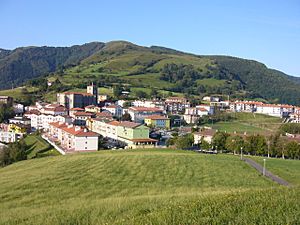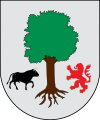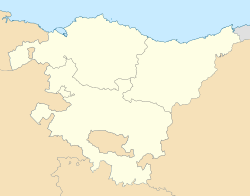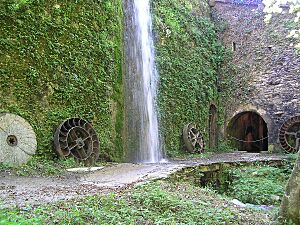Aia facts for kids
Quick facts for kids
Aia
|
||
|---|---|---|

Aia
|
||
|
||
| Country | ||
| Autonomous community | ||
| Province | Gipuzkoa | |
| Comarca | Urola Kosta | |
| Population
(2018)
|
||
| • Total | 2,081 | |
| Time zone | UTC+1 (CET) | |
| • Summer (DST) | UTC+2 (CEST) | |
| Postal code |
20809
|
|
| Dialing code | 34 (Spain) + 943 (Gipuzkoa) | |
Aia is a charming village in the Basque Country, Spain. It sits on the side of Mount Pagoeta in the province of Gipuzkoa. Aia is about 30 kilometers west of Donostia-San Sebastián. It is also about 10 kilometers away from the coast, near the town of Zarautz.
Aia is surrounded by beautiful hills, forests, and mountains. The town has a large church called the Church of San Esteban. This church has a very special centerpiece inside. The number of people living in Aia has slowly gone down since the 1950s. In 2005, about 1,750 people lived there.
Contents
Aia's Past: A Look at History
Early Life in Aia
People have lived in the Aia area for a very long time. Scientists believe humans were here over 10,000 years ago. They found cave paintings, carvings, and stone tools that show this.
The town of Aia itself is mentioned in one of the oldest papers from Gipuzkoa. This document dates back to the year 1025. Aia was also part of the "Union of Sayaz" in a special rule from 1375.
Farming and Iron Production
Long ago, farming was the main way people made a living in Aia. Families in small villages grew their own food and made what they needed. They lived in a self-sufficient way, meaning they provided for themselves. The land was usually owned by the town and rented to farmers.
Over time, people started to develop special skills. Aia became very important for making iron. This was because there was a lot of natural iron in the ground nearby. Many places where iron was melted and shaped, called foundries, were built here. These foundries helped the local population grow a lot. Many family lines in Aia started from these iron-making businesses.
However, these old iron-making places, called forges, eventually closed down. This happened when new machines called blast furnaces were invented. These new furnaces used coal, which was more efficient for making iron.
Exploring Aia: Fun Things to See and Do
Aia is located in the middle of Basque farmlands. It looks much like it did hundreds of years ago. There are several interesting places to visit.
Pagoeta Nature Reserve
To the west of Aia, you'll find the Pagoeta Nature Reserve. This large park covers about 1,335 acres (5.4 square kilometers). It helps protect the natural environment and the history of the area. Inside the park, you can see old ruins of mills, foundries, and farmhouses. There are also ancient burial mounds that are about 5,000 years old.
Agorregi Forge: A Glimpse into the Past
The Agorregi Forge is inside the Pagoeta Nature Reserve. It is one of the best-preserved examples of an old iron foundry in Gipuzkoa. The forge you see today was built in 1754. It was built by the Lord of Laurgain Palace on top of an even older forge.
This forge is in a deep valley near the Manterola farmhouse. It used the power of the river's water to make its machines work. The water turned its wheels and powered its bellows, which are like giant air pumps.
Iturraran Botanic Garden: A World of Plants
Also near Aia, within the Pagoeta Nature Reserve, is the Iturraran Botanic Garden. This garden was created in 1986. It has more than 1,000 different kinds of plants, trees, and bushes from all over the world. You can also find some rare and endangered plants from the Basque Country here.
Aia's Neighbourhoods: A Community Map
Aia is a municipality, which means it's a local government area. It includes the main town of Aia and several smaller areas called neighbourhoods. These neighbourhoods are like tiny villages.
There are eleven neighbourhoods in Aia:
- Alzola (Altzola): This area has 11 people living there.
- Andatza o San Pedro: This is a larger neighbourhood with 249 people.
- Arratola Aldea: 38 people live here.
- Arrutiegia: 106 people live in this neighbourhood.
- Elcano (Elkano): 100 people live here. This neighbourhood is also partly in the town of Zarauz.
- Etxetaballa: 45 people live here.
- Iruretaegia: 97 people live in this area.
- Kurpidea: 59 people live here.
- Laurgain: 78 people live in this neighbourhood.
- Olaskoegia: 202 people live here.
- Santio Erreka: This is one of the larger neighbourhoods with 254 people.
- Urdaneta: 78 people live here.
The main town of Aia itself has about 470 people living in it.
See also
 In Spanish: Aya para niños
In Spanish: Aya para niños





